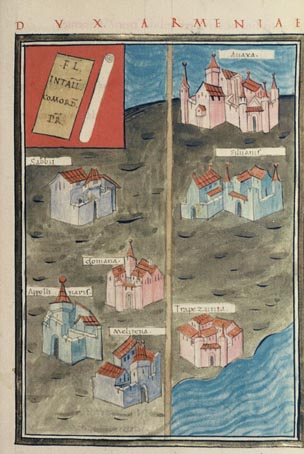
This page created 18 December 2001, and last modified: 31 December 2014 (Discussion about Ala Rizena updated)

 Frontpiece from the Bodleian manuscript (O). The stations depicted are: Avaxa, Sabbu, Domana, Silvanus, Apollonaris, Melitena, Trapezunta. |
The following units (or detachments of units), and prefects and their units, are listed as being under the command of the Duke of Armenia (the numbers in front of the names refer to Ingo Maier's numbering scheme):
71.2 Equites sagittarii, at Sabbu while the following units and officers along with their men are recorded separately as being in Pontus:
71.7 Praefectus legionis primae Ponticae, at Trapezunta and the following units are described as being from a "lesser register":
71.13 Ala prima Augusta Colonorum, at Chiaca |
The Cohors Mochora could be interpreted to mean either "Cohors Mochora (location missing)", or "Cohors (name missing), at Mochora"; the latter is probably more likely since a location called Mogaro is known from the Antonine Itinerary (205.1); and thus this was Seeck's preferred reading. M.A.Speidel (2009, 'The Development of the Roman Forces in Northeastern Anatolia', available here) interpreted this to mean the unit may have been newly created, along with Ala castello Tablariensi constituta, which also has no name, just a location: "stationed at Fort Tablariensi". Similarly, while the Ala prima pretorica nuper constituta is "newly stationed", it is not clear if "pretorica" is the unit's name or station (Note that in Seeck, OR.XXXVIII.26, this is amended to "praetoria").
The Froben edition gives 71.8 and 71.9 as a single item: the ALA Rizena Dalearizae, and Seeck similarly conflated them (OR.XXXVIII.17), as the Ala Rizena (at) Aladaleariza. This is because the as the 3rd century Antonine Itinerary gives a location (215.13) called "Olotoedariza" (and variant spellings in different manuscripts). However, all the primary extent manuscripts give them as two separate items. For example the Parisian manuscript, P, reads:
In Ponto.while the Munich manuscript, M, gives:Praefectus legionis prime pontice
trapezunta. Ala rizena. Ala
dade ariza. Ala theodosiana
apud anaxam. Ala felix theodo
siana silvanis
In PontoLike M, the Bodleian manuscript, O, and the Vatican manuscript, V, have Ala dale ariza following Ala Rizena (Ingo Maier, personal communication). Rizena would appear to refer to ancient Rhizaion on the Black Sea coast - see Speidel, above. Speidel seems to have taken Seeck's reading for granted, and thus proposed the Ala Rizena may have been transferred inland to "Aladaleariza" not long before the Notitia was drawn up. This explanation is unnecessary if there are actually two different units involved, because then both could be still at their assigned locations.Praefectus legionis primae ponticae
trapezunta,
Ala rizena,
Ala dale ariza,
Ala theodosiana apud Auaxa.
Ala felix theodosiana Siluanis,
The men under the Praefectus legionis quintadecimae Apollinaris are clearly Legio XV Apollinaris Pia Fidelis, still stationed at Satala (modern Sadagh in Erzeroum, Armenia), where they had been the garrison since the early 2nd century (note that the frontpiece illustration gives Apollonaris as a location instead of Satala). The men under the Praefectus legionis duodecimae fulmin(at)ae are likewise Legio XII Fulminata Galliena, which was apparently stationed at Melitena (modern Malatia in Turkey) from the time of Vespasian in the 1st century, and where it is still stationed according to the Notitia.
In contrast, Legio I Pontica appears to have been a Tetrarchic creation, based in Trapezus (modern Trabzon in Turkey) on the Black Sea. A detachment of this unit is apparently (see more below) listed as serving in the Magister Peditum's Italian command, as the Pontinenses. Its shield pattern is as given below:

That under O comes from the Bodleian manuscript in Oxford, that under P from the Paris manuscript, that under M from the first portion of the Munich manuscript, that under W from the second portion of the Munich manuscript, and that under B from the Froben printed edition. This is most unlikely to have been the pattern born by the detachment of Legio I Pontica stationed at Trapezus, however, as units transferred to a field army from a garrison station seem to have been given new shield patterns. Further, it is far from certain that the Pontinenses is actually related to Legio I Pontica, since other derivations of the name are possible - see the unit's page for further details.
Many of the units under the Dux Armeniae had been in the area since the days of Arrian (ca. 135) - the following units can be identified from his works (taken from M.A.Spiedel; see above):
Ala I Augusta (Gemina) ColonorumSome of the other units listed in the Notitia are attested epigraphically from Arrian's time even though they are not identified in his work - see Spiedel for details.
Ala (II Uplia) Auriana
Ala I Ulpia Dacorum
Ala II Gallorum
Cohors III Ulpia Petraeorum (milliaria equitata sagittaria)
Cohors IIII Raetorum (equitata)
Cohors (I) Bosporiana (milliaria equitata sagittaria)
Cohors (I) Germanorum (milliaria equitata)
Cohors Apuleia civium Romanorum

Return to the Notitia index page.